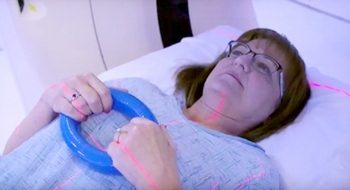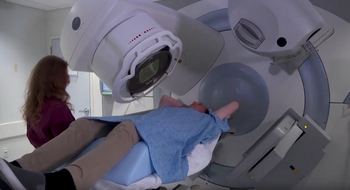Step-by-Step Through Treatment
We understand that dealing with cancer can be very stressful. We want to provide you and your loved ones with additional information to help you navigate the process of radiation therapy. This section will take you step-by-step through your journey, from the initial consultation all the way through to post-treatment follow-up visits.
Preparing for Radiation Therapy
Step 1: Consultation
 Your first visit to radiation oncology is a consultation with the radiation oncologist and your care team including a resident physician and a registered nurse. You will not receive a radiation treatment at this visit. Plan to be in the clinic for two or more hours. This is an important visit to learn about your medical history and treatment needs. For most patients the visit will include:
Your first visit to radiation oncology is a consultation with the radiation oncologist and your care team including a resident physician and a registered nurse. You will not receive a radiation treatment at this visit. Plan to be in the clinic for two or more hours. This is an important visit to learn about your medical history and treatment needs. For most patients the visit will include:
- Physical examination
- Review medical history, MRI, CT or other imaging, and medication review
- Discussion of treatment options
Wait times: Please schedule your appointment so that you can be in the clinic a minimum of two hours. It may take several minutes for the doctors to thoroughly review your case before they speak with you.
After this visit you may be scheduled to start the radiation process, or you may be asked to return for a follow-up visit depending on the type of cancer and your individual treatment plans.
For you and the doctor to get the most out of your visit, see our What to Expect From Your First Appointment section.
Step 2: Simulation
If it is determined that you will start radiation therapy, there are many steps in preparation for your start date. For most types of treatment, a simulation (SIM) appointment will be scheduled. The purpose of this visit is to outline or map the exact area to be treated. A CT scan will be taken to verify the anatomy and assure accuracy. If needed, immobilization devices such as a face mask or a leg mold will be made at this time. Your skin will be marked with small dots of permanent ink (tattoos) to ensure that the precise area is treated each time.
The SIM visit takes about one hour. Some patients will receive IV contrast. Be sure to follow any preparation instructions provided by your doctor or nurse.
During the SIM visit the radiation therapist will discuss treatment times and reserve a space for you depending on how many treatments you’ll be receiving.
Step 3: Treatment planning
After simulation, you’ll have a few days to a few weeks to relax while your radiation oncologist creates a unique plan of treatment taking into account your diagnosis, the type of radiation machine that will be used, the amount of radiation needed and the number of treatments to be given.
Step 4: Radiation Treatment
The number of treatments prescribed will vary depending on your specific cancer type and its location. Your experience will be completely different from that of other patients and may differ from previous radiation treatment you may have had.
There are many different radiation therapy options, and the radiation oncologist will discuss with you the most appropriate plan. A full course of therapy may take several weeks, while other treatments may be one day or just a few days.
Treatments are given Monday to Friday for the number of visits determined during planning. Typically your treatment is scheduled for the same time each day. A licensed radiation therapist will administer your treatment.
Some patients may experience side effects from their treatment. Visit our Frequently Asked Questions section for more information. Please talk to your treatment team if you have any questions or concerns.
Follow-up Appointments
When your course of treatment is completed, your radiation oncologist will need to see you for follow-up visits. You will be given instructions about the intervals at which you will need to be seen, and you can make your first follow-up appointment when you complete treatment.







